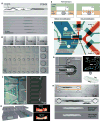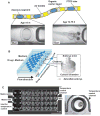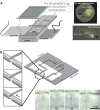Microfluidic tools for developmental studies of small model organisms--nematodes, fruit flies, and zebrafish
- PMID: 23161817
- PMCID: PMC3918482
- DOI: 10.1002/biot.201200129
Microfluidic tools for developmental studies of small model organisms--nematodes, fruit flies, and zebrafish
Abstract
Studying the genetics of development with small model organisms such as the zebrafish (Danio Rerio), the fruit fly (Drosophila melanogaster), and the soil-dwelling nematode (Caenorhabditis elegans), provide unique opportunities for understanding related processes and diseases in humans. These model organisms also have potential for use in drug discovery and toxicity-screening applications. There have been sweeping developments in microfabrication and microfluidic technologies for manipulating and imaging small objects, including small model organisms, which allow high-throughput quantitative biological studies. Here, we review recent progress in microfluidic tools able to manipulate small organisms and project future directions and applications of these techniques and technologies.
Copyright © 2013 WILEY-VCH Verlag GmbH & Co. KGaA, Weinheim.
Conflict of interest statement
The authors declare no conflict of interest.
Figures




Similar articles
-
Drug Discovery in Fish, Flies, and Worms.ILAR J. 2016 Dec;57(2):133-143. doi: 10.1093/ilar/ilw034. ILAR J. 2016. PMID: 28053067 Free PMC article. Review.
-
Technologies for micromanipulating, imaging, and phenotyping small invertebrates and vertebrates.Annu Rev Biomed Eng. 2011 Aug 15;13:185-217. doi: 10.1146/annurev-bioeng-071910-124703. Annu Rev Biomed Eng. 2011. PMID: 21756142 Review.
-
Application of Caenorhabditis elegans (nematode) and Danio rerio embryo (zebrafish) as model systems to screen for developmental and reproductive toxicity of Piperazine compounds.Toxicol In Vitro. 2017 Oct;44:11-16. doi: 10.1016/j.tiv.2017.06.002. Epub 2017 Jun 26. Toxicol In Vitro. 2017. PMID: 28595837
-
Microfluidics for mechanobiology of model organisms.Methods Cell Biol. 2018;146:217-259. doi: 10.1016/bs.mcb.2018.05.010. Epub 2018 Jul 14. Methods Cell Biol. 2018. PMID: 30037463 Free PMC article.
-
Developmental genetics with model organisms.Proc Natl Acad Sci U S A. 2022 Jul 26;119(30):e2122148119. doi: 10.1073/pnas.2122148119. Epub 2022 Jul 18. Proc Natl Acad Sci U S A. 2022. PMID: 35858396 Free PMC article.
Cited by
-
Microstructured Surface Arrays for Injection of Zebrafish Larvae.Zebrafish. 2017 Apr;14(2):140-145. doi: 10.1089/zeb.2016.1402. Epub 2017 Feb 2. Zebrafish. 2017. PMID: 28151697 Free PMC article.
-
Microfluidic-Assisted Caenorhabditis elegans Sorting: Current Status and Future Prospects.Cyborg Bionic Syst. 2023 Apr 14;4:0011. doi: 10.34133/cbsystems.0011. eCollection 2023. Cyborg Bionic Syst. 2023. PMID: 37287459 Free PMC article.
-
Correlative imaging across microscopy platforms using the fast and accurate relocation of microscopic experimental regions (FARMER) method.Rev Sci Instrum. 2017 May;88(5):053702. doi: 10.1063/1.4982818. Rev Sci Instrum. 2017. PMID: 28571460 Free PMC article.
-
A Microfluidic System for Stable and Continuous EEG Monitoring from Multiple Larval Zebrafish.Sensors (Basel). 2020 Oct 19;20(20):5903. doi: 10.3390/s20205903. Sensors (Basel). 2020. PMID: 33086704 Free PMC article.
-
Microfluidic systems for modeling human development.Development. 2022 Feb 1;149(3):dev199463. doi: 10.1242/dev.199463. Epub 2022 Feb 14. Development. 2022. PMID: 35156682 Free PMC article.
References
-
- Tissenbaum HA, Guarente L. Model organisms as a guide to mammalian aging. Dev Cell. 2002;2:9–19. - PubMed
-
- Jenner RA, Wills MA. The choice of model organisms in evo-devo. Nat Rev Genet. 2007;8:311–314. - PubMed
-
- Narashimhan MG. Model organisms in biology: Scientific other uses. J Biosci. 1999;24:141–142.
-
- Berghmans S, Butler P, Goldsmith P, Waldron G, et al. Zebrafish based assays for the assessment of cardiac, visual and gut function — potential safety screens for early drug discovery. J Pharmacol Toxicol Methods. 2008;58:59–68. - PubMed
Publication types
MeSH terms
Grants and funding
LinkOut - more resources
Full Text Sources
Other Literature Sources
Molecular Biology Databases

